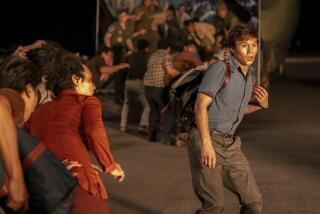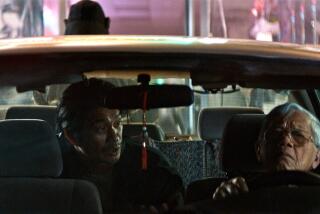1968 Tet Offensive Marked Turning Point in U.S. Loss in Vietnam
BANGKOK, Thailand — It was just past midnight on Jan. 31, 1968. The lull of the Tet lunar New Year holiday had settled across South Vietnam--and the United States was within minutes of the pivotal point from which it eventually lost the Vietnam War.
While Army Spec. 4 Charles L. Daniel stood guard at the U.S. Embassy in Saigon, Nguyen Van Sau of the Viet Cong’s C-10 battalion sped toward him in a taxi. Before it was over, Daniel and Sau were dead. So were more than 81,000 other Americans and Vietnamese.
On that night 20 years ago today, about 80,000 Communist troops struck at 36 of 44 provincial capitals plus 64 district towns across the length and breadth of South Vietnam.
On the Asian calendar Tet marked the start of the Year of the Monkey--a creature, according to superstition, full of mischief and therefore portending a year in which a lot of things can go wrong.
Lost Battles, Won War
For the South Vietnamese and their American defenders, superstition became terrible reality. The year’s first moments brought the opening volleys of the Communist Tet offensive, the set of battles North Vietnam and the guerrilla Viet Cong lost over the next two months--as a result of which they won the war seven years later.
Nothing so historic was in the mind of American GI Alan Dawson, living with his fiancee’s family in the Cholon Chinese district of Saigon, who remembers: “I woke up to the pitter-patter of rubber sandals going over the roof.”
They were “Communist sappers,” said Dawson, “on the way to hit a police station down the road.” Dawson survived to become UPI bureau manager in Saigon.
Fate was not so kind to 23-year-old Daniel, of Durham, N.C., who with Pfc. William E. Sebast, 20, of Albany, N.Y., were the first to witness the unthinkable--Viet Cong guerrillas battering their way into the fortress-like grounds of the six-story American Embassy.
Sau and his fellow guerrillas poured from the taxi and blasted into the compound. Daniel and Sebast radioed a “Signal 300,” a code for “enemy attack,” then opened fire on the invaders.
“They’re coming in, they’re coming in,” Daniel yelled into his radio--then nothing. He and Sebast and three other U.S. defenders of the embassy were among the first of 3,895 Americans killed before the remnants of the Tet offensive were mopped up March 31, 1968.
In Ban Me Thuot, a Central Highlands town of 65,000, U.S. military policeman Ron McCollar, figuring the Vietnamese tradition of setting off firecrackers at Tet would be a perfect cover for a Communist attack, was clearing out the five bars that catered to Americans.
Minutes later more than 2,000 Viet Cong guerrillas--some of whom had infiltrated the city with Tet merrymakers--blasted through Ban Me Thuot’s tree-lined streets, leaving what journalist Don Oberdorfer described as “a horror of blood, bullets, death and destruction.”
Just outside Ban Me Thuot, a group of American missionaries dived for cover in a garbage pit they had converted into a bunker. When North Vietnamese soldiers swarmed toward them, missionary Robert Ziemer raised his hands--and was cut down by bullets in his head and chest.
Fellow missionary Ed Thompson screamed, “Mercy, mercy,” and died in a hail of bullets, trying without success to shield his wife, Ruth, as he fell.
In the ancient imperial capital of Hue, about 400 miles north of Saigon, American Marines were pinned down in two tiny enclaves on either side of the Perfume River. It would take 25 days before they could claw out the Viet Cong and rip down their yellow-starred flag.
The Tet offensive raged from the mud of the Mekong Delta in the south to the leech-infested, booby-trapped hills of the north in South Vietnam. Before it was over, more than 81,000 people died--nearly 4,000 Americans, 4,954 South Vietnamese, 214 South Koreans, an estimated 58,400 North Vietnamese and Viet Cong and 14,300 civilians.
But it was the audacious assault on the U.S. Embassy and the grim, door-to-door battle by American Marines through the streets of Hue that captured and focused the attention of Americans at home on the horror--and eventually the futility--of Vietnam.
That, and one other vignette that touched off worldwide revulsion: the murder of a Communist suspect, in full view of news and television cameras, by South Vietnam’s national police chief, Brig. Gen. Nguyen Ngoc Loan.
Ignoring the cameramen, Loan--many of whose men had been killed that day--raised a pistol to the head of the terrified suspect and pulled the trigger.
Psychological Turning Point
Two decades later, arguments still rage whether Tet was a brilliant coup or a resounding military defeat for the Communists. But most observers, both hawks and doves, agree it was the psychological turning point of the war.
Before Tet, the U.S. military--and the American people--believed America was winning the war. Tet viciously demonstrated that was not true.
Within two months after Tet, President Lyndon B. Johnson had dropped out of the presidential race, the bombing of North Vietnam was restricted and Hanoi agreed to start peace talks in Paris.
Meanwhile, the movement to withdraw from Vietnam began to find support among even the conservative middle class.
Gen. Maxwell D. Taylor, former chairman of the Joint Chiefs of Staff and ambassador to Vietnam, wrote later that it was a “disastrous military defeat for Hanoi,” but that, because of “defeatist reporting” by American journalists, “the enemy scored a psychological victory in the United States and abroad.”
Divisive for Communists
Tet was also divisive for the Communists, despite their official party history insistence that the offensive “dealt a lightning blow to the Americans and puppets.”
Gen. Tran Van Tra, a senior southern Communist commander, complained in a military history published in 1982 that the party set objectives “that were beyond our actual strength.”
“We suffered large losses in material and manpower, especially cadres at various echelons, which clearly weakened us,” said Tra, who later lost most of his official positions.
The heavy losses meant that after Tet, the bulk of the fighting was done by North Vietnamese troops. Many of the leading southern Communist cadre, who had been under cover in the cities, popped up to lead the expected “popular uprising,” and when it never came, fled into the jungle to become targets of heavy American bombing.
“This is why the south is run by northerners today,” said a bitter southern Communist over a beer in old Saigon, now renamed Ho Chi Minh City. “At Tet, you Americans killed most of our best people.”
In contrast to other watershed dates in the war, the Tet anniversary will be given only low-key remembrance in Vietnam.
Provincial officials in Vietnam have invited those who fought in the battles of Tet to return to the places where so many of their compatriots died, for a reunion on the 20th anniversary.
But, said a Vietnamese Embassy official in Bangkok, “There is not going to be any major celebration. It will be just old comrades getting together again.”
More to Read
Sign up for Essential California
The most important California stories and recommendations in your inbox every morning.
You may occasionally receive promotional content from the Los Angeles Times.










